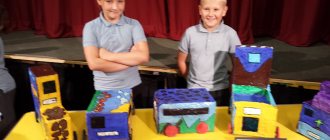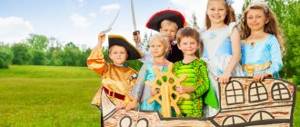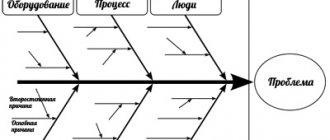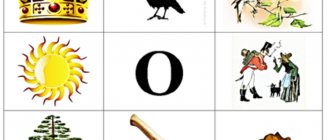Using technology techniques for developing critical thinking in elementary school lessons
Olga Sergeevna Nesterova, primary school teacher, Municipal Budgetary Educational Institution "Secondary School No. 6", NyaganEmail: [email protected] Ilyinykh Lidiya Mikhailovna, primary school teacher, Municipal Budgetary Educational Institution "Secondary School No. 6", Municipal Budgetary Educational Institution "Nyagan"Email Using techniques of technology for the development of critical thinking in lessons in primary school AbstractB
The article introduces the technology for the development of critical thinkingB The use of technology techniques in elementary school forms universal learning activities for students, develops critical thinking BKey words: critical thinking, technology, techniques, universal learning activities, challenge stage, comprehension stage, reflection stageB
The federal state standard of the second generation says “the development of the student’s personality on the basis of mastering universal educational actions, knowledge and mastery of the world is the goal and main result of education” [1]. Therefore, the main task of the teacher in any lesson is to form universal educational actions BFormation of universal educational actions of the student, according to the developers standard, can only be ensured as a result of the student’s activity in conditions of choice, accompanied by the teacher using individually oriented technologies. Therefore, the development and implementation of modern educational technologies becomes relevant. Modern educational technologies include: distance learning technology, productive learning technology, health-saving technologies, information and communication technologies , learning in collaboration (team, group work); technology of using game methods in teaching, developmental learning, problem-based learning, collective learning system (CTE), technology for solving inventive problems (TRIZ), research methods in teaching, project teaching methods, debate technology, technology of modular and block-modular training, lecture-seminar-credit training system , technology for the development of critical thinking and others B In recent years, the method of developing critical thinking has become popular B Developers of the “Technology for the Development of Critical Thinking through Reading and Writing” (TRKM) Americans Charles Temple, Kurt Meredith, Ginny Still, Dona Ogle B In Russia, the technology has been mastered since 1997 B Thinking critically is: showing curiosity ;use research methods; ask yourself questions; carry out a systematic search for answers; reveal the causes and consequences of facts; doubt in generally accepted truths; development of a point of view and the ability to defend it with logical arguments; attention to the opponent’s arguments and their logical comprehension. The purpose of this technology is to develop students’ thinking skills, necessary not only in school, but also in everyday life (the ability to accept informed decisions, work with information, analyze various aspects of phenomena, etc. B)B
The role of the teacher in TRKM: directs the efforts of students in a certain direction; confronts various judgments; creates conditions that encourage making independent decisions; gives students the opportunity to draw their own conclusions; prepares new cognitive situations within existing onesBadvantages of critical thinking technology gives the student: increasing the efficiency of information perception; increasing interest both in the material being studied and in the learning process itself; ability to think critically; the ability to take responsibility for one’s own education; ability to work collaboratively with others; improving the quality of student education; the desire and ability to become a person who learns throughout his life B The basic model of technology consists of three stages: the challenge stage, the semantic stage and the reflection stage B This lesson structure, according to psychologists, corresponds to the stages of human perception: first you need to tune in, remember what you know from this topic; then get acquainted with new information; then think about why you will need the acquired knowledge and how you can apply it B The first stage is challenge B Its presence in every lesson is mandatory B This stage allows you to: update and generalize the student’s knowledge on a given topic or problem; arouse sustained interest in the topic being studied, motivate the student to study activities; encourage the student to actively work in the classroom and at homeB At the challenge stage, methodological techniques are used: “Cluster”, “Basket of Ideas”, “Let’s Delve into Memory”, “Association”, “Confused Logical Chains”, “Instructions”. Cluster is a graphic organization of material , showing the semantic fields of a particular concept B The word “cluster” in translation means a bunch, a constellation B Creating a cluster allows students to think freely and openly about any topic B The student writes down a key concept in the center of the sheet, and from it draws arrows rays in different directions that connect this word with others, from which the rays, in turn, diverge further and further B The cluster can be used at a variety of stages of the lesson B At the challenge stage to stimulate mental activity B At the comprehension stage for structuring educational material B At the reflection stage when summarizing what students have learned B The cluster can be used also for organizing individual and group work, both in the classroom and at home. For example, when studying the topic “Prefix as part of a word” in the second grade, children, generalizing their knowledge of prefixes, use a cluster compiled in the lesson. Figure 1 Cluster “Prefix as part of a word”
The “Basket of Ideas” technique is a technique for organizing individual and group work of students at the initial stage of the lesson, when they are updating their existing experience and knowledgeB It allows you to find out everything that students know or think about the topic of the lessonB On the board you can draw an icon of a basket in which conditionally, everything that all students know together about the topic being studied will be collected B The exchange of information is carried out according to the following procedure: the student writes down in a notebook everything that he knows about the problem B Exchange of information in pairs or groups Groups in a circle name information, facts B The teacher writes everything on the board B Linking into logical chains , correcting errors as new information is learned B Technique “True and false statements” B This technique can be the beginning of a lesson B Students choose “true statements” from those proposed by the teacher, describe a given topic (situation, setting, system of rules) B Then students determine whether the data is correct statements, justifying their answerB After getting acquainted with the basic information (the text of the paragraph, a lecture on this topic), they return to these statements and evaluate their reliability, using the information received in the lesson BFor example, in a lesson about the surrounding world when studying the topic “Mushrooms”, the teacher asks students to play game “Do you believe that...” B Rules of the game: 1 B On the desks there are pieces of paper on which a table is drawn, like on a blackboard B Numbers indicate the numbers of questions B 2. Questions are read that begin with the words “Do you believe that ...” The answer is discussed in pairs
Do you believe that...1....mushrooms are plants 2....mushrooms are capped 3....mushrooms are tubular 4....mushrooms are lamellar 5....mushrooms are green 6....mushrooms reproduce using spores 7....mushrooms can , like plants, create nutrients 8. ... mushrooms can be grown in the garden 9. ... you cannot pick unfamiliar mushrooms 10 ... you can pick mushrooms wherever you find them Next, the teacher finds out what questions caused difficulty and what needs to be studied in the lesson BCorrect answers are checked after studying the entire topic B Second stage comprehension B This stage allows the student to: obtain new information; make sense of it; correlate with existing knowledge BTechniques used at this stage: “Insert”, “Reading with stops”, “Fishbone” or “Fishbone”. Techniques for working with tables: “Table PlusMinusInteresting (PMI)”, “TableIKnowIWannaKnowIKnow(ZKH)”, “TableSynthesis”, “Pivot Table”, “Conceptual Table”, table “What? Where? When? Why?". “Thick and Thin Questions”, “Chamomile of Questions” (“Bloom’s Chamomile”). Reception “Table ZHU”B If you want to collect the material already available on the topic during the lesson, expand your knowledge on the issue being studied, systematize it, then the table “ I know I want to know I found out" B Using this table, children put together their existing knowledge on this topic, substantiate and systematize the incoming data. ZHU", the third column is filled out by the children when summing up the lesson at the reflection stage. Table 2 Table "ZHU"
I knowBI want to knowBLearned1BMultiplication and division tablesB1BHave we studied all types of equationsB1BWhat to solve an equation means to find all its roots2BName of the components of actionsB2BAre there any difficulties in solving equations, and what onesB2BWhat when reading equations and letter expressions, the names of the letters x, y and z of the masculine gender, the names of other Latin letters neuter, it is not customary to inflect the names of letters in mathematicsB3BWhat is an equationB3BAlgorithm for solving equationsB3B That the French scientist Rene Descartes in the 16th century introduced the familiar alphabetic notation of equationsB
4B Simple Equation AlgorithmB
“Insert” technique or conventional symbolsB The goal is to optimize the processing of text using a sign system. Children are invited to work through the text using certain conventional symbols. B Students read the text, at the same time, making notes in the margins: “V”
already knew, “+”new, “”thought differently, “?”
I don’t understand, I have questions. After reading the text, fill out the “Insert” table, where the icons become the headings of the columns of the table. Information from the text is briefly entered into the table. This technique works at the comprehension stage. For example, in a Russian language lesson in the fourth grade when studying the topic “VerbB Change.” verbs in the present tense by persons and numbers.”
At the stage of comprehension, work with the text takes place B Students read the text independently, using notes B “V” knew this information, I know, remembered; “+” this is information that is new to me; "?" this information is not clear to me, I have questions BText “Words that denote the actions of objects are called verbsB Verbs answer the questions what to do? what is he doing? what are they doing? what to do? what will he do? what will they do? Verbs are inflected by numberB If a verb is associated with a singular noun, then it answers the questions what does it do? what will he do? If a verb is associated with a plural noun, then it answers the questions what are they doing? what will they do? The verb changes according to tenses B The verb has three tenses: present, past and future B The present tense of the verb denotes an action that is being performed now, at the time when it is being spoken about: reads (what does it do?) B The past tense of the verb denotes an action that has taken place previously: read (what did?), read (what did?) B The future tense of the verb denotes an action that will be performed after it was spoken about: will read (what will he do?), read (what will he do?) B If the verb answers the questions what to do?, what to do? and it is impossible to determine either time or number, this is the indefinite form of the verb B Verbs in the past tense in the singular change according to gender B In the masculine gender they have a zero ending, in the feminine gender they have a zero ending, in the feminine they have a ending a, in the middle ending oB (The lily of the valley has blossomed B The strawberry has blossomed B The tree has blossomed B) Verbs in the present and future tense change in person and number, that is, they are conjugatedB They have three persons (1e, 2e, 3e) and two numbers (singular and plural)B I, we are the first personB You, you are the second personB He, she, it, they is a third person B The endings of verbs in the present tense are personal endings B After working with the text, students fill out the “Insert” table B Listen to all the statements recorded in the table B The table should look something like this: Table 3 “Insert” table V (already knew )+ (new information)? (there are questions)1BVerbs denote the action of an objectB
2BIndefinite form of the verbB3BChange of verbs by personB4BVerb questionsB5BChange of verbs in the past tenseB6BPersonal endings of verbsB7BChange by numberB8BChange by tenseB
1Bverbs in the present and future tense change in person and numberB2BThe endings of verbs in the present tense are personal endings of verbsBB1BHow to determine the person of a verb?2BWhy can’t you determine the person of past tense verbs?3BWhat does “verbs are conjugated” mean?4BHow many conjugations does a verb have?
If students have questions that go beyond the scope of the proposed text, it is necessary to recommend sources that can be consulted to find answers outside of class time. The “Table of Thick and Thin Questions” technique can be used at any of the three stages of the lesson: at the challenge stage, these are questions before studying the topic ; at the comprehension stage, a method of actively fixing questions as you read and listen; upon reflection, a demonstration of what has been learned B Teaching children the skill of distinguishing questions can already begin in the second grade B For example, when studying the topic “Prefix is part of a word” B Work is underway in groups B Each group formulates three “Subtle” questions B Sample questions: What is a prefix? Where is the console located? What is the attachment used for? Are there many prefixes in the Russian language? How are prefixes designated? BNext, students make up one “Thick” question each. B Questions could be: Why is the prefix called a “prefix”? How do prefixes differ from suffixes? Can prefixes form new words? What is the difference between a prefix and a root? Can a word have two or three prefixes? Fishbone or Fishbone technique. In the head of the skeleton there is a problem that is considered in trainingB On the skeleton itself there are upper and lower bonesB On the upper bones the causes of the problem are noted, on the lower ones facts are written out confirming the presence of the stated reasonsB[2] For example, in a Russian language lesson on the topic “The role of adjectives in speech", students are asked to conduct an investigative experiment, during which they answer the question: what role do adjectives play in speech? As the study progresses, they fill out the diagram BFigure 2
Fishbone pattern
After filling out the “Fish Skeleton” diagram, they conclude: people use adjectives to describe objects, human characterB Adjectives help us more clearly describe the beauty of nature, decorate our speechB
The third stage of reflectionBHere the main thing is: holistic comprehension, generalization of the information received; appropriation of new knowledge, new information by the student; formation of each student’s own attitude to the material being studied B Techniques at the reflection stage: “Essay”, “Raft”, “Diamanta”, “Cinquain”, “Hoku” (Haiku), Logbook, “Two-Part Diary”, “Three-Part Diary”, “Six thinking hats.” For example, when studying the topic “VerbB Changing verbs in the present tense by persons and numbers” at the reflection stage we use the “Raft” technique
(Children are already familiar with this technique) Guys, let's summarize our lesson B You need to orally compose a short text B At home you can write it down B One limitation: the text will be on behalf of the Verb B (Children receive signs reminding them what parameters of the text they should become familiar with B) P role B On whose behalf will you write? A audienceB Who will you write to? F in what form will you write (anecdote, story, dialogue, essay) B Topic B What will your text focus on? What is its main idea? An example of the resulting text in the form of a dialogueB
Guys, hello B I am a part of speech that denotes the action of an object B Who am I?
Verb!
CorrectB Today in class you talked a lot about meB What do you remember most?
Present tense verbs change according to persons and numbersB
Well done! What is conjugation?
This is the change in persons and numbersB
I'm not saying goodbye to you! Until next time! Reception “Cinquain”B In translation from French, the word “cinquain” means a poem consisting of five lines, which is written according to certain rules: in the first line the topic is called in one word (usually a noun)B The second line is a description of the topic in a nutshell (two adjectives)B The third line is a description of the action within this topic in three words (verbs)B The fourth line is a four-word phrase showing the attitude towards the topic (feelings in one phrase)B The last line is a one-word synonym that repeats the essence of the topicB For example, at the end of the lesson you can invite the children to compose a “Sinquain” on the topic “The water cycle in nature.” “Sinquain” can turn out to be: Water Transparent, fresh; Evaporates, collects, falls out B A constant phenomenon in nature B Cycle B Technique “Writing an essay.” The meaning of this technique can be expressed in the following words: “I write in order to understand what I think” B This is a free letter to a given task a topic in which independence, manifestation of individuality, debatability, originality of problem solving, argumentation are valuedB Usually, an essay is written directly in class after discussing the problem and takes no more than 5 minutesB
Bloom's Chamomile technique Simple questions (factual questions) require knowledge of factual material and are focused on memory work Clarifying questions “as far as I understood...B”, “Did I understand you correctly that...” Interpretive questions (explanatory) encouraging students to interpretations Evaluative questions (comparison) should be used when you hear that one of the students expresses to their neighbor their dissatisfaction or pleasure with what happened in the lesson Creative questions (prediction) “What do you think will happen next...?” Practical questions “ How we can…?" “What would you do...?” The “Tree of Predictions” technique was borrowed by the authors from an American colleague, JB Bellance, who works with literary text. B This technique is suitable for developing the ability to argue and justify one’s predictions.
The topic should contain a question addressed to the future, for example, “How will the story end?”, “Will the main character be saved?”, “Why does the boy Petya keep falling and falling?” and other “branches” of assumptions that follow two main directions “possibly” and “probably” (the number of “branches” is not limited) B “leaves”
justification for these assumptions, arguments in favor of this or that opinion. All versions must be argued based on the proposed text, and not on one’s own conjectures and fantasies; after reading the text, children return to their assumptions and see which of them came true and which did not and whyB you should not use the technique more than once in a lesson; Technique “Six Hats of Critical Thinking” This technique is usually used at the stage of generalization and systematization B tbeB at the stage of reflection B The essence of the technique is as follows: the class is divided into six groups, each group “tryes on its hat”, six points of view are expressed on the same problem B “White hat” statistical (states the facts on the problem, without discussing them) B “Yellow hat”
positive (positive points are expressed) B “Black hat” negative (the group states negative points on the problem being studied) B “Blue hat”
analytical (analysis is carried out: the group answers the questions: Why?, Why?, Connections?) B “Green hat” creative (you can express the most “crazy” ideas and assumptions) B “Red hat” emotional (the group formulates their emotions that they tested while working with the material).
For example, when summarizing the lesson “Polygons, Rectangles and Squares” in 2nd grade, we use the “Six Thinking Hats” technique
Those who received the “White Hat” will list to us which figures they met in the lesson and name their properties. Those who received the “Yellow Hat” will tell us what interesting, useful things they learned in the lesson. B Those who received the “Black Hat” will share with with their difficulties, problems, they will tell us what was unclear BThose who have the “Red Hat” will tell you what emotions they experienced in the lesson, did your mood change BThose who received the “Green Hat”, try to suggest where the knowledge gained can be useful? who “Blue Hat” must carefully listen to the answers of all “hats” and draw a conclusion on today’s lesson B Any technique used in the TCRM technology must be performed correctly and have a logical conclusion B At the “challenge” stage, the children must formulate the topic B Throughout the lesson, the teacher coordinator B At stage of “reflection” it is necessary to make the transition to studying the next topicB
Links to sources1BFederal State Educational Standard for Primary General EducationB https://standart.edu.ru/catalog.aspx?CatalogId=959
2. Gavrysh SVBB, Application of schemes website: https://gsv.ru3Grudzinskaya.EBYUB Pedagogical technology “Development of critical thinking through reading and writing” in the training of specialistsB Vestnik NNGUB Issue 1(6), 2005B https://www.unn.ru /pages/issues/vestnik/99990199_West_innov_2005_1(6)/23.pdf4B ZairBek SVIB Development of critical thinking through reading and writing: stages and methodological techniques CC School DirectorB 2005B No. 4. 5BZairBek SVIB, Mushtavinskaya IVB Development of critical thinking in the classroomB ManualB for teachersB MB : Enlightenment, 2004B 173 cB
6BZagashev IVOB, ZairBek SVIB, Mushtavinskaya IVVB Teaching children to think criticallyB SPbB: Alliance “Delta”, 2003B
.
7. Clarin MBB Development of critical and creative thinking CC School technologies B 2004B No. 2B CB310.
Nesterova Olga Sergeevna, primary school teacher, SCHOOL No. 6 “MBOW, Nyagan Email Lidiya Mikhailovna Ilienyh, primary school teacher, SCHOOL No. 6” MBOW, Nyagan Email: [email protected]
Technology development techniques Using critical thinking in the classroom in elementary school. Abstract. The article introduces the technology of developing critical thinking. The use of technology in elementary school techniques form the students ' allround education, develop critical thinking. Keywords:critical thinking, technology, techniques, training, universal stage, stagecomprehension, stagereflexion.
Examples of working with the Prediction Tree technique
When studying text in literature lessons (geography, history)
The text of the work is not fully read. A tree of assumptions is being built, the branches of which will contain options for possible endings. As arguments, it is important to provide facts taken from the text of the work itself (What situations suggest such a development of events? What qualities of the hero can influence the situation?).
To reinforce a grammatical topic
For example, in an English lesson, the technique will help in consolidating verb forms in the future tense.
Situation: a forecast has been received from the Research Center, which describes possible prospects for the development of humanity.
Students’ assumptions are made using the constructions “May be...if”, “Will be...”.
When learning a new topic
The “prediction tree” technique can help update knowledge and make predictions about a new topic.
For example, in math class you are going to study the Pythagorean theorem. On the tree of predictions, students’ guesses about which axioms might be used will appear as branches.
At the stage of consolidating the material and monitoring knowledge
For this stage of the lesson, the “prediction tree” technique is used as a way to check how well students have mastered the topic and are able to argue their point of view. At the same time, predictions can be the most fantastic; what is important is the ability to prove, present the correct arguments and prerequisites for such a development of events.
For example, in a social studies lesson you finished a topic about the political regime in the Russian Federation. Now, together with your students, build a “prediction tree”, in which the question will be proposed as a “trunk” (topic): The political situation in the Russian Federation in 20/50 years. For the “branches,” students give their predictions: “strengthening/weakening of democratic foundations,” “increasing return to a one-party structure,” etc. It is important that the “leaves” of the tree are filled in, where the arguments and prerequisites for such a probability will be indicated.







